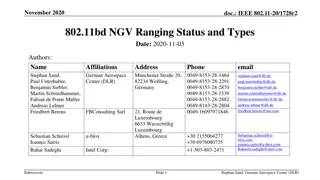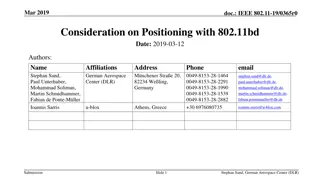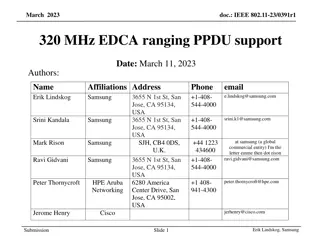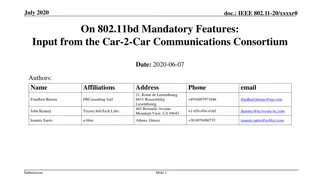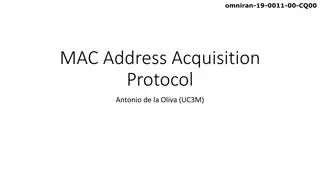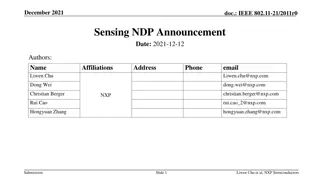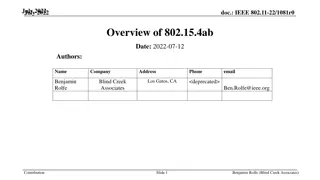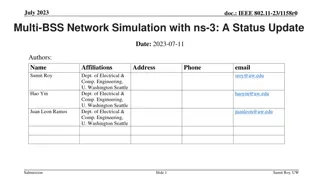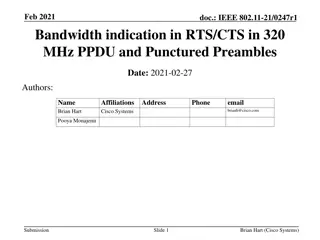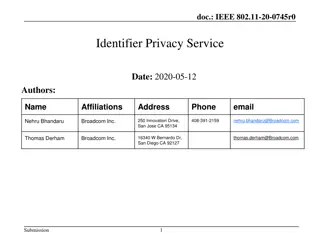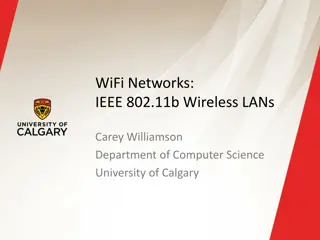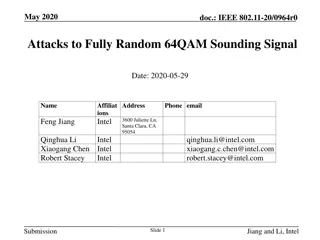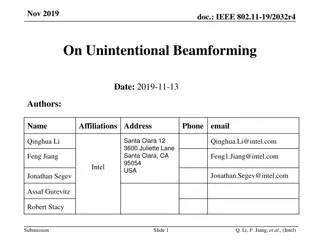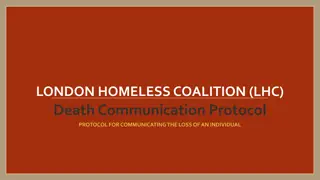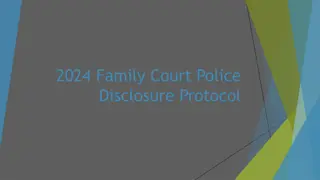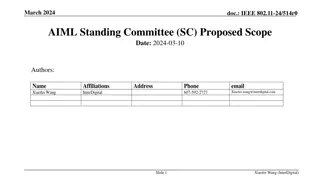IEEE 802.11-20/1761r1 Ranging Protocol for 11bd
This document outlines the ranging protocol proposed for IEEE 802.11-20/1761r1, focusing on RTT-based ranging leveraging multi-channel operation. By integrating the 11az ranging protocol, it enables flexible and low-overhead application in 11bd for improved accuracy in ITS bands. The protocol includes capability discovery, parameter negotiation, measurement sequence exchange, and tear down phases, offering solutions for associated and non-associated STAs.
Download Presentation

Please find below an Image/Link to download the presentation.
The content on the website is provided AS IS for your information and personal use only. It may not be sold, licensed, or shared on other websites without obtaining consent from the author. Download presentation by click this link. If you encounter any issues during the download, it is possible that the publisher has removed the file from their server.
E N D
Presentation Transcript
November 2020 doc.: IEEE 802.11-20/1761r1 Ranging in 11bd Date: 2020-11-6 Authors: Name Affiliation Address Phone Email Bahar Sadeghi 503-803-2471 Bahareh.sadeghi@intel.com Qinghua Li Intel Corp. Jonathan Segev Submission Slide 1
November 2020 doc.: IEEE 802.11-20/1761r1 Background 11bd PAR [1]: This amendment defines procedures for at least one form of positioning in conjunction with V2X communications Use Case (UC) baseline document [2]: UC5 Vehicular Positioning & Location UC8 Train-to-Train UC9 Vehicle-to-Train There have been multiple ranging contributions in TGbd [2][3][4][5][6][7] Various techniques have been studied [8] Ranging performance of C2C channel model and free-space LOS path loss model simulated/analyzed sub-meter accuracy is possible Draft 1.0: Optional feature: RTT based ranging using 10 and 20 MHz bandwidth PPDUs Submission Slide 2
November 2020 doc.: IEEE 802.11-20/1761r1 Abstract This submission proposes ranging protocol for 11bd RTT based Reuse 11az ranging protocol leveraging1609 multi-channel operation Flexible and low-overhead application of 11az in 11bd Ranging can occur in ITS band or other 802.11 bands Enables use of higher BW channels for higher accuracy ranging where applicable Use of 11az PHY security and different options possible Minimal changes/spec work required in 11bd Submission 3
November 2020 doc.: IEEE 802.11-20/1761r1 11az Ranging Overview 11az ranging includes three parts: Capability discovery o During which a ranging responder advertises ranging capability in beacon (indicating whether it supports secured or non-secured, bi-directional measurement report feedback or not, trigger based or non-trigger based) Ranging parameter negotiation o Initiator and responder use FTM request/response to negotiate number of spatial time streams, bandwidth, LTF format and location measurement report (LMR) feedback type, etc. Measurement sequence exchange o Responder and Initiator exchange NDP frames and the location measurement report (LMR) using trigger-based sequence (MU scenario) or non-trigger based sequence (SU scenario) ) Tear down o May be implicit or explicit o 11az defines ranging solution for both associated and non-associated STAs. 11az un-associated solution applies better to 11bd o Submission 4
November 2020 doc.: IEEE 802.11-20/1761r1 1609 Multi-Channel Operation 1609.4 specifies the multi-channel operation for 802.11p/bd Upon startup, STA monitors the Control Channel (CCH) until a Service Advertisement is received for a Service Channel (SCH), or the device decides to utilize the SCH based on its announcements To transmit on SCH, a STA transmits WAVE Announcement Action Frames on CCH Broadcast messages Other STAs receive the announcement and establishes communication with the provider on SCH Can be either unicast or multicast Provider/user relationship Supports WSMP or IP packet Occurs only on SCH Submission 5
November 2020 Multi-channel 11az Ranging in 11bd doc.: IEEE 802.11-20/1761r1 ISTA RSTA Wave Announcement frame(s) Ranging Service Negotiation using higher layer exchanges 11az capability discovery SCH rendezvous May be a channel in 5.9 GHz band May be a channel outside 5.9 GHz band May be the same channel CCH Switch to SCH Switch to SCH Option A Option B ISTA RSTA RSTA ISTA NTB ranging sequence 11az ranging sequence Ranging Service measurement 11az Pre-association security negotiation (optional) 11az parameter negotiation NTB measurement sequence No PHY security 11az termination (may be implicit) Ranging Service measurement 11az PASN (optional) 11az parameter negotiation 11az measurements PHY security (optional) 11az termination (may be implicit) Non 5.9 GHz IEEE band 5.9 GHz band Submission 6
November 2020 Benefits of multi-channel 11az ranging doc.: IEEE 802.11-20/1761r1 11az defines the latest ranging solution for 802.11 including PHY security Multi-channel adaptation of 11az for 11bd enables 11az features for OCB and more Capability discovery is handled via 1609.4 mechanisms Flexible channelization operation If non-ITS 802.11 channels available, higher BW can be used for higher ranging accuracy If limited to ITS channels, then 1609.4 multi-channel enables flexible and efficient operation Minimum changes required in 11bd specification NDP and 11az control frames definition for 11bd (similar to other signal formats already defined in 11bd) for ranging in ITS band Submission 7
November 2020 doc.: IEEE 802.11-20/1761r1 11bd spec work required (1/2) Capability Discovery: Using higher layer messages Spec work: indication of possibility of this option. Parameters to be either fixed or negotiated at the end of the procedure TBD. Unassociated security context establishment Can be skipped per higher layer exchanges i.e., capability/use case/policy Needs PMK to be provided by the higher layers. Can be provided as ranging certificate similar to how it is done for other use cases 3 frame exchange: Use of 11az messages. Spec work: 11az PASN text updated for two non-AP STAs (12.13.3.2) 5.9 GHz band: 11az Management frames carried in NGV PPDU format non-5.9 GHz band: no change Submission 8
November 2020 doc.: IEEE 802.11-20/1761r1 11bd spec work required (2/2) 11az parameter negotiation 2 action frames (FTM request and FTM) Spec work: 5.9 GHz band: 11az action frames carried in NGV PPDU format non-5.9 GHz band: no change 11az measurement sequence NTB in 5.9 GHz band All of 11az measurements sequence available on other bands Spec work: definition of NGV NDP: NGV PPDU Data NGV NDPA: NGV PPDU version LMR: management frame carried in NGV PPDU format Secure LTF Available as is on non-ITS bands. Not supported on ITS bands. Spec work: none Submission 9
November 2020 doc.: IEEE 802.11-20/1761r1 References [1] 11-18/0861r9 TGbd PAR [2] 11-19/1342r1 TGbd Use Case Document [3] 11-19/788r3 considerations on ranging in NGV [4] 11-19/859r0 ranging performance in 11bd [5] 11-19/1892r0 on ranging methods for NGV [6] 11-19/2011r0 ranging protocols in 11bd [7] 11-19/1929r1 influence of delay-close multi-path components on FTM- RTT [8] 11-20/1728r0 802.11bd ranging status and types Bahar Sadeghi, Intel Submission Slide 10
November 2020 doc.: IEEE 802.11-20/1761r1 Backup Bahar Sadeghi, Intel Submission Slide 11
November 2020 doc.: IEEE 802.11-20/1761r1 Non-trigger Based Ranging Sequence 11az non-trigger based (NTB) measurement sequence with bidirectional LMR is shown below Applied to peer-to-peer ranging scenario (initiator and responder) The measurement sequence is initiated by initiator STA After measurement report exchange, both of initiator and responder obtain range estimation LMR2 (t1, t4) NDPA NDP1 Initiator SIFS SIFS SIFS LMR1 (t2, t3) NDP2 Responder SIFS Submission 12
November 2020 doc.: IEEE 802.11-20/1761r1 Submission 13





